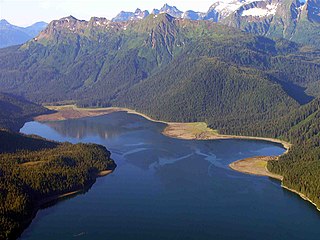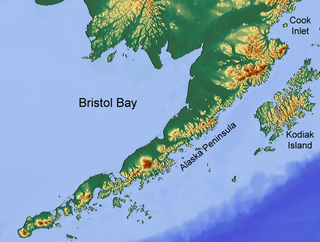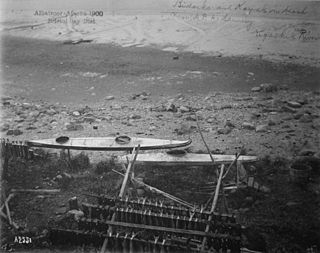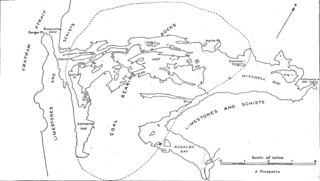| King Salmon River | |
|---|---|
| Location | |
| Country | United States |
| State | Alaska |
| Census Area | Hoonah–Angoon |
| Physical characteristics | |
| Source | Admiralty Island |
| - location | Kootznoowoo Wilderness, Admiralty Island National Monument |
| - coordinates | 58°03′41″N134°32′22″W / 58.06139°N 134.53944°W |
| - elevation | 2,847 ft (868 m) [1] |
| River mouth | King Salmon Bay, Seymour Canal |
| - location | 18 miles (29 km) south of Juneau |
| - coordinates | 58°02′31″N134°20′27″W / 58.04194°N 134.34083°W Coordinates: 58°02′31″N134°20′27″W / 58.04194°N 134.34083°W [2] |
| - elevation | 10 ft (3.0 m) [2] |
| Length | 11 mi (18 km) [2] |
The King Salmon River is a small stream on the northern tip of Admiralty Island of Southeast Alaska, United States.

Admiralty Island is an island in the Alexander Archipelago in Southeast Alaska, at 57°44′N134°20′W. It is 145 km (90 mi) long and 56 km (35 mi) wide with an area of 4,264.1 km2 (1,646.4 sq mi), making it the seventh largest island in the United States and the 132nd largest island in the world. It is one of the ABC islands of Alaska. The island is nearly cut in two by the Seymour Canal; to its east is the long, narrow Glass Peninsula. Most of Admiralty Island—more than 955,000 acres (3,860 km2)—is occupied by the Admiralty Island National Monument - a federally protected wilderness area administered by the Tongass National Forest. The Kootznoowoo Wilderness encompasses vast stands of old growth temperate rainforest. These forests provide some of the best habitat available to species such as brown bears, bald eagles, and Sitka black-tailed deer.

Southeast Alaska, sometimes referred to as the Alaska Panhandle, is the southeastern portion of the U.S. state of Alaska, bordered to the east by the northern half of the Canadian province of British Columbia. The majority of Southeast Alaska's area is part of the Tongass National Forest, the United States' largest national forest. In many places, the international border runs along the crest of the Boundary Ranges of the Coast Mountains. The region is noted for its scenery and mild rainy climate.
It flows eastward then south for a total distance of 11 miles (18 km) from headwaters in the low mountains just south of Eagle Peak into King Salmon Bay of the Seymour Canal. Its entire course lies within Kootznoowoo Wilderness of the Admiralty Island National Monument.

Seymour Canal is an inlet penetrating deep into the southeastern part of Admiralty Island, Southeast Alaska, United States. The inlet was first charted in 1794 by Joseph Whidbey, master of HMS Discovery during George Vancouver's 1791–95 expedition. Vancouver later named it "Seymour's Channel". Two large islands are located within it: Swan Island to the north, and Tiedeman Island just to its south.

The temperate rainforests of Admiralty Island's Kootznoowoo Wilderness are unique among the 5,700,000 acres (2,300,000 ha) of federally protected Wilderness in Southeast Alaska.

Admiralty Island National Monument is a United States National Monument located on Admiralty Island in Southeast Alaska, and is managed as part of the Tongass National Forest. It was created December 1, 1978, and covers 955,747 acres (3,868 km2) in Southeast Alaska. The remoteness of the monument led Congress to pass legislation designating all but 18,351 acres (74 km2) of the monument as the Kootznoowoo Wilderness, ensuring that the vast bulk of this monument is permanently protected from development. The monument is administered by the U.S. Forest Service from offices in Juneau.
A relatively small river, it is not navigable. Besides its namesake king salmon, the river hosts a large annual run of pink salmon.

Pink salmon or humpback salmon is a species of anadromous fish in the salmon family. It is the smallest and most abundant of the Pacific salmon. The scientific species name is based on the Russian common name for this species gorbúša (горбуша), which literally means humpie.












